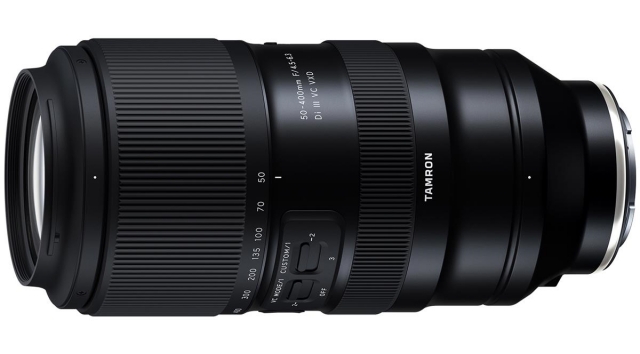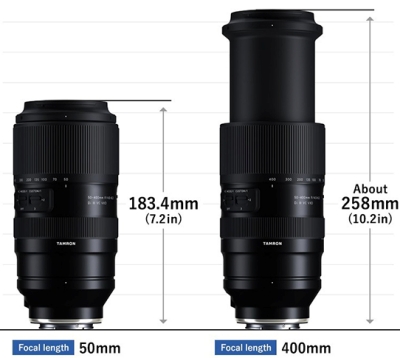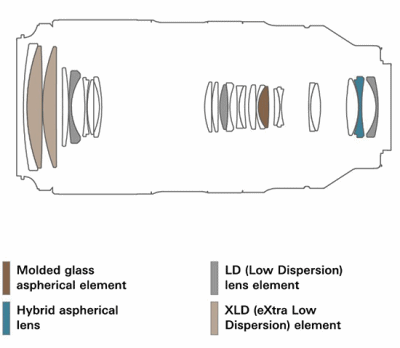TAMRON 50-400mm F/4.5-6.3 Di III VC VXD (for Sony E-mount): Designed for handheld use, Tamron’s capable new 8x zoom features weather-resistant sealing, fast autofocusing, integrated dual-mode stabilisation and easy customisation. It will appeal to those looking for a single lens from the ‘standard’ 50mm focal length to a long telephoto range. Most potential buyers will want to photograph sports and wildlife with the camera hand-held. It could also suit families looking for a general-purpose lens for photographing or shooting videos of children in action. The excellent close-focusing capabilities will be welcomed by photographers who enjoy taking close-ups of flowers, small animals and birds.
RRP: With a US price of US$1299, it’s fairly expensive locally at an RRP of $2399 – but fortunately, street prices are way down on the distributor’s RRP.
 Only 183.4 mm long at 50mm and extending to approximately 258 mm at 400mm, with a weight of just 1.15Kg, the Tamron 50-400mm f/4.5-6.3 Di III VC VXD lens is designed for hand-held use. Its outer and inner barrels appear to be made mostly of composite polycarbonate on a metal mount. Build quality is very sound and the lens is supplied with front and end caps plus a petal-shaped hood – but no tripod collar. (It accepts the same Model A035TM collar as the Tamron 100-400mm f/4.5-6.3 Di VC USD (Model A035) lens.)
Only 183.4 mm long at 50mm and extending to approximately 258 mm at 400mm, with a weight of just 1.15Kg, the Tamron 50-400mm f/4.5-6.3 Di III VC VXD lens is designed for hand-held use. Its outer and inner barrels appear to be made mostly of composite polycarbonate on a metal mount. Build quality is very sound and the lens is supplied with front and end caps plus a petal-shaped hood – but no tripod collar. (It accepts the same Model A035TM collar as the Tamron 100-400mm f/4.5-6.3 Di VC USD (Model A035) lens.)
The optical design is complex, consisting of 24 elements in 18 groups and including two XLD (eXtra Low Dispersion) elements, along with three LD (Low Dispersion) elements and two aspherical elements. Tamron’s proprietary BBAR (Broad-Band Anti-Reflection) coating is applied to suppress internal reflections and the front surface of the lens is fluorine-coated for easy cleaning. Nine diaphragm blades produce a circular aperture for attractive bokeh and 18-pointed sunstars when the lens is stopped down. No claims are made for the VC (Vibration Compensation) stabilisation but we found it very effective at longer focal lengths. It also provides two selectable modes – standard and panning – and AI processing can provide special compensation for shooting video at focal lengths up to 100mm.
 Tamron’s Lens Utility software enables users to customise the focus set button for one of the following modes:
Tamron’s Lens Utility software enables users to customise the focus set button for one of the following modes:
– A-B focus set, which allows you to select two positions an make the focus shift automatically between them;
– pre-set a focus distance and move the focus to the recorded point with a single button press;
– switch between AF and MF modes;
– restrict the focus range (new to the 50-400mm lens);
– switch focus ring adjustment to aperture adjustment;
– assign one of the functions available from the camera menu to the Focus Set Button;
– clear custom settings.
Imatest testing showed the lens to be a very good performer across the 50-200mm range of focal lengths we were able to measure. Our measurements showed high resolution from the centre to about half way out, although softening was found near the edge of the frame. High central zone resolution persisted through to f/11 where diffraction began to take effect.
In-camera corrections in Sony full-frame cameras can eliminate relatively minor issues with vignetting, rectilinear distortion and chromatic aberration. Backlighting was handled well, although flare artefacts were produced when a light source was within the frame. Sunstars at f22 and f32 were mostly sharp and well-defined.
Purchasing Points:
1. This lens covers a unique zoom range that extends from the ‘standard’ 50mm to a 400mm ‘ultra-telephoto’ focal length. There is no other lens from either Sony or another third-party manufacturer covering that specific range, which is suitable for photographing sports and wildlife and could also appeal to car and aero enthusiasts.
2. Autofocusing is fast and accurate thanks to VXD (Voice-coil eXtreme-torque Drive) linear voice-coil motors. Tamron claims they provide positional accuracy down to 0.005 mm, which we found to be credible.
 3. Near silent operation of focusing and zooming allows close-up photography and video to be recorded with the longer focal length settings, including in situations where the subjects are very small bush birds that could be easily spooked by noise.
3. Near silent operation of focusing and zooming allows close-up photography and video to be recorded with the longer focal length settings, including in situations where the subjects are very small bush birds that could be easily spooked by noise.
4. Close-up shooting extends into the ‘half-macro’ range with the 50mm and 70mm focal lengths both offering 1:2 magnification ratios. A reproduction ratio of 1:4 is provided at the minimum object distance of 1.5 metres with the 400mm focal length.
5. The zoom ring turns smoothly through a small arc of 75 degrees between the 50mm and the 400mm positions, making quick adjustments to the focal length easy. This extends the inner barrel by almost 75 mm while the maximum aperture closes with a swap to f5 at 69mm, then again to f5.6 at 106mm ending up at f6.3 from 149mm to 400mm.
6. The lens is also compatible with Sony-specific functions like Eye AF, Fast-Hybrid AF and in-camera lens corrections for vignetting, chromatic aberration and distortion. It also supports Direct Manual Focus (DMF) in AF mode.
7. Nine rubber gaskets seal vulnerable regions against possible entry of moisture and dust, while a fluorine coating on the front element repels moisture and dust and prevents fingerprint marks from reducing image quality.
8. This lens can accept the same 67 mm diameter filters as eight other Tamron lenses, ranging from the 20mm, 24mm and 35mm f2.8 primes through to the 17-28mm, 28-75mm f2.8 and 70-180mm zooms, 28-200mm f2.8-5.6 zoom and 70-30mm f4.5-6.3 zoom. The new 20-40mm f2.8 Di III VXD lens also use 67 mm filters.
https://tamron.com.au/our-products/50-400mm-f-4-5-6-3-di-iii-vc-vxd-model-a067/
– Margaret Brown
![]() For a more extensive review of the Tamron 50-400mm, including performance charts, click here.
For a more extensive review of the Tamron 50-400mm, including performance charts, click here.





Be First to Comment